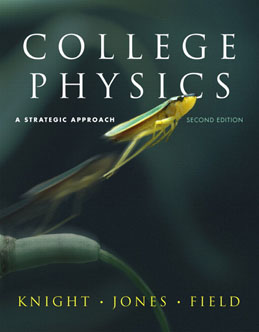Test Bank for College Physics: A Strategic Approach, 2nd Edition, Randall D. Knight, Brian Jones, Stuart Field,
$55.00 Original price was: $55.00.$29.99Current price is: $29.99.
Test Bank for College Physics: A Strategic Approach, 2nd Edition, Randall D. Knight, Brian Jones, Stuart Field,
Test Bank for College Physics: A Strategic Approach, 2nd Edition, Randall D. Knight, Brian Jones, Stuart Field

Product details:
- ISBN-10 : 0321595491
- ISBN-13 : 978-0321595492
- Author: Randy Knight
Building on the research-proven instructional techniques introduced in Knight’s Physics for Scientists and Engineers, the most widely adopted new physics book in more than 30 years, College Physics: A Strategic Approach set a new standard for algebra-based introductory physics–gaining widespread critical acclaim from professors and readers alike.
For the Second Edition, Randy Knight, Brian Jones, and Stuart Field continue to apply the best results from educational research, and refine and tailor them for this course and the particular needs of its readers. New pedagogical features (Chapter Previews, Integrated Examples, and Part Summary problems) and fine-tuned and streamlined content take the hallmarks of the First Edition—exceptionally effective conceptual explanation and problem-solving instruction—to a new level. More than any other book, College Physicsleads readers to proficient and long-lasting problem-solving skills, a deeper and better-connected understanding of the concepts, and a broader picture of the relevance of physics to their chosen career and the world around them.
Table contents:
Full Version, All Chapters: Chs 1-30 Volume 1: Chs 1-16 Volume 2: Chs 17-30 PART I FORCE AND MOTION OVERVIEW The Science of Physics Representing Motion 1.1 Motion: A First Look 1.2 Models and Modeling 1.3 Position and Time: Putting Numbers on Nature 1.4 Velocity 1.5 A Sense of Scale: Significant Figures, Scientific Notation, and Units 1.6 Vectors and Motion: A First Look 1.7 Where Do We Go from Here? SUMMARY QUESTIONS AND PROBLEMS Motion in One Dimension 2.1 Describing Motion 2.2 Uniform Motion 2.3 Instantaneous Velocity 2.4 Acceleration 2.5 Motion with Constant Acceleration 2.6 Solving One-Dimensional Motion Problems 2.7 Free Fall SUMMARY QUESTIONS AND PROBLEMS Vectors and Motion in Two Dimensions 3.1 Using Vectors 3.2 Coordinate Systems and Vector Components 3.3 Motion on a Ramp 3.4 Motion in Two Dimensions 3.5 Projectile Motion 3.6 Projectile Motion: Solving Problems 3.7 Circular Motion 3.8 Relative Motion SUMMARY QUESTIONS AND PROBLEMS Forces and Newton’s Laws of Motion 4.1 Motion and Forces 4.2 A Short Catalog of Forces 4.3 Identifying Forces 4.4 What Do Forces Do? 4.5 Newton’s Second Law 4.6 Free-Body Diagrams 4.7 Newton’s Third Law SUMMARY QUESTIONS AND PROBLEMS Applying Newton’s Laws 5.1 Equilibrium 5.2 Dynamics and Newton’s Second Law 5.3 Mass and Weight 5.4 Normal Forces 5.5 Friction 5.6 Drag 5.7 Interacting Objects 5.8 Ropes and Pulleys SUMMARY QUESTIONS AND PROBLEMS Circular Motion, Orbits, and Gravity 6.1 Uniform Circular Motion 6.2 Dynamics of Uniform Circular Motion 6.3 Apparent Forces in Circular Motion 6.4 Circular Orbits and Weightlessness 6.5 Newton’s Law of Gravity 6.6 Gravity and Orbits SUMMARY QUESTIONS AND PROBLEMS Rotational Motion 7.1 Describing Circular and Rotational Motion 7.2 The Rotation of a Rigid Body 7.3 Torque 7.4 Gravitational Torque and the Center of Gravity 7.5 Rotational Dynamics and Moment of Inertia 7.6 Using Newton’s Second Law for Rotation 7.7 Rolling Motion SUMMARY QUESTIONS AND PROBLEMS Equilibrium and Elasticity 8.1 Torque and Static Equilibrium 8.2 Stability and Balance 8.3 Springs and Hooke’s Law 8.4 Stretching and Compressing Materials 8.5 Forces and Torques in the Body SUMMARY QUESTIONS AND PROBLEMS PART I SUMMARY Force and Motion ONE STEP BEYOND Dark Matter and the Structure of the Universe
People also search:
college physics a strategic approach 2nd edition pdf
college physics a strategic approach 2nd edition answers
college physics a strategic approach 2nd edition
college physics a strategic approach ap edition answers
Related products
Test Bank
Test Bank for Clinical Immunology and Serology A Laboratory Perspective, 3rd Edition: Stevens
Test Bank
Test Bank for Essentials of Business Law and the Legal Environment, 11th Edition: Richard A. Mann
Test Bank
Test Bank for Operating Systems: Internals and Design Principles, 7th Edition: William Stallings











